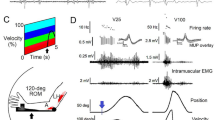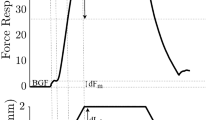Abstract
Static and dynamic components of the stretch reflex were studied in elbow flexors of 13 hemiparetic brain-injured individuals. Constant-velocity joint rotations were applied to the elbow, and the resulting stretch reflex torque and electromyographic responses were recorded in the biceps brachii and brachioradialis muscles. Ten elbow extension velocities between 6 and 150 ° s-1 were applied in random order. The resulting reflex torque response was plotted as a function of elbow angle and fitted with a mathematical model designed to depict elbow flexor activation. We found that four of the six model parameters were essentially independent of test velocity. Conversely, 73% (19/26) of cases involving the other two model parameters were dependent on velocity of joint extension (p<0.05). We conclude from these results that four of the model parameters reflect the static reflex response while the two remaining velocity-dependent parameters reflect the dynamic reflex response. To describe overall velocity dependence of stretch reflexes in spastic elbow muscles, the two dynamic reflex parameters were fitted to a fractional exponential function of velocity, similar to a model previously used to describe spindle firing rate in the cat hindlimb. We found that the mean velocity exponent of the dynamic reflex parameters was 0.24 + 0.17 (s.d.) (N = 13), a value similar to that for muscle spindle velocity sensitivity in reduced animal preparations. We conclude that both static and dynamic reflex sensitivities can be measured by examining different aspects of the torque/angle relation associated with the reflex response to a large-amplitude ramp stretch of the elbow. © 2001 Biomedical Engineering Society.
PAC01: 8719St, 8719Ff, 8710+e
Similar content being viewed by others
References
An, K. N., F. C. Hui, B. F. Money, R. L. Linsheid, and E. Y. Chao. Muscles Across the Elbow Joint: A Biomechanical Analysis. J. Biomech.14:659–669, 1981.
Ashworth, B.Preliminary trial of carisoprodal in multiple sclerosis. Practitioner192:540–542, 1964.
Buchanan, T. S., D. P. J. Almdale, J. L. Lewis, and W. Z. Rymer. Characteristics of synergic relations during isometric contractions of human elbow muscles. J. Neurophysiol.56:1225–1241, 1986.
Buchanan, T. S., G. P. Rovai, and W. Z. Rymer. Strategies for muscle activation during isometric torque generation at the human elbow. J. Neurophysiol.62:1201–1212, 1989.
Edin, B. B., and A. B. Vallbo. Dynamic response of human muscle spindle afferents to stretch. Neurophysiol.63:1297–1306, 1990.
Eldred, E., R. Granit, and P. A. Merton. Supraspinal control of the muscle spindles and its significance. J. Physiol. (London)122:498–523, 1953.
Fugl-Meyer, A. R., L. Jaasko, I. Leyman, S. Olsson, and S. Steglind. The post-stroke hemiplegic patient. I. A method for evaluation of physical performance. Scand. J. Rehab. Med.7:13–31, 1975.
Given, J. D., J. P. A. Dewald, and W. Z. Rymer. Joint dependent passive stiffness in paretic and contralateral limbs of spastic patients with hemiparetic stroke. J. Neurol. Neurosurg. Psychiatry59:271–279, 1995.
Houk, J. C., and W. Z. Rymer. Neural control of muscle length and tension. In: The Nervous System, edited by J.M. Brookhart and V.B. Mountcastle. Bethesda, MD: American Physiological Society, 1981, pp. 257–324.
Houk, J. C., W. Z. Rymer, and P. F. Crago. Dependence of dynamic response of spindle receptors on muscle length and velocity. J. Neurophysiol.46:143–168, 1981.
Katz, R. T., G. P. Rovai, C. Brait, and W.Z. Rymer. Objective quantification of spastic hypertonia: Correlation with clinical findings. Arch. Phys. Med. Rehabil.73:339–347, 1992.
Knutsson, E. Quantification of spasticity. In: Electromyography and Evoked Potentials, edited by A. Struppler and A. Weindl. Berlin: Springer, 1985, pp. 84–91.
Lance, J. W. Pathophysiology of spasticity and clinical experience with baclofen. In: Spasticity: Disordered Motor Control, edited by R. G. Feldman, R. R. Young, and W. P. Koella. Chicago, IL: Year Book, 1980, pp. 185–203.
Lennerstrand, G., and U. Thoden. Position and velocity sensitivity of muscle spindles in the cat. II. Dynamic fusimotor single-fibre activation of primary endings. Acta Physiol. Scand.74:16–29, 1968.
Matthews, P. B. C.The dependence of tension upon extension in the stretch reflex of the soleus muscle of the decerebrate cat. J. Physiol. (London)147:521–546, 1959.
Matthews, P. B. C.A study of certain factors influencing the stretch reflex of the decerebrate cat. J. Physiol. (London)147:547–564, 1959.
Matthews, P. B. C.The response of de-efferented muscle spindle receptors to stretching at different velocities. J. Physiol. (London)168:660–678, 1963.
Matthews, P. B. C. Muscle spindles: Their messages and their fusimotor supply. In: The Nervous System, edited by J. M. Brookhart and V. B. Mountcastle. Bethesda, MD: American Physiological Society, 1981, pp. 189–228.
Murray, W. M., S. L. Delp, and T. S. Buchanan. Variation of muscle moment arms with elbow and forearm positions. J. Biomech.28:513–525, 1995.
Nichols, T. R., and J. C. Houk, Improvement in linearity and regulation of stiffness that results from actions of stretch reflex. J. Neurophysiol.39:119–142, 1976.
Prochazka, A. Proprioceptive feedback and movement regulation. In: Handbook of Physiology, Section 12: Exercise: Regulation and Integration of Multiple Systems, edited by L. B. Rowell and J. T. Shepard. New York: American Physiological Society, 1996, pp. 89–127.
Prochazka, A., and M. Gorassini. Models of ensemble firing of muscle spindle afferents recorded during normal locomotion in cats. J. Physiol. (London)507:277–291, 1998.
Rymer, W. Z., and R. T. Katz. Mechanical quantification of spastic hypertonia. In: Physical Medicine and Rehabilitation: State of the Art Reviews, edited by R. T. Katz. Philadelphia, PA: Hanley & Belfus, Inc., 1994, pp. 455–463.
Schmit, B. D., Y. Dhaher, J. P. A. Dewald, and W. Z. Rymer. Reflex torque response to movement of the spastic elbow: Theoretical analyses and implications for quantification of spasticity. Ann. Biomed. Eng.27:815–829, 1999.
Vallbo, A. B.Afferent discharge from human muscle spindles in non-contracting muscles: Steady state impulse frequency as a function of joint angle. Acta Physiol. Scand.90:303–318, 1974.
Author information
Authors and Affiliations
Rights and permissions
About this article
Cite this article
Schmit, B.D., Rymer, W.Z. Identification of Static and Dynamic Components of Reflex Sensitivity in Spastic Elbow Flexors Using a Muscle Activation Model. Annals of Biomedical Engineering 29, 330–339 (2001). https://doi.org/10.1114/1.1359496
Issue Date:
DOI: https://doi.org/10.1114/1.1359496




